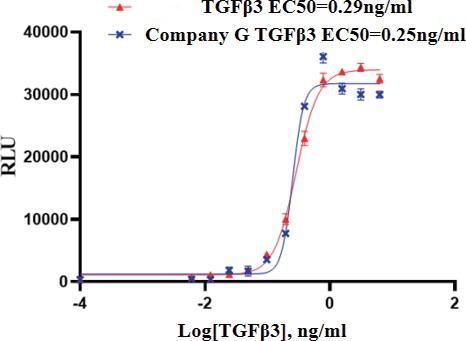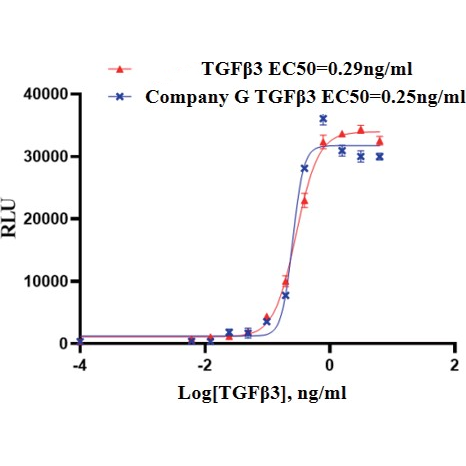Measured by (CAGA)12-luciferase reporter assay.
Product Details
Product Details
Product Specification
| Species | Human |
| Synonyms | ARVD; ARVD1; FLJ16571; LDS5; RNHF; TGFB3; TGFbeta 3; TGF-beta 3; TGF-beta3; TGF-beta-3; transforming growth factor beta-3; transforming growth factor, beta 3. |
| Accession | P10600 |
| Concentration | 0.2mg/ml |
| Amino Acid Sequence | Ala301-Ser412 |
| Expression System | HEK293 |
| Molecular Weight | 12.7 kDa (monomer). |
| Purity | ≥95% by SDS-PAGE |
| Conjugation | Unconjugated |
| Tag | No Tag |
| Physical Appearance | Liquid |
| Storage Buffer | Dissolved in sterile 20 mM sodium citrate(pH=2.5) buffer . This solution can be diluted into other aqueous buffers. Centrifuge the vial prior to opening. |
| Stability & Storage |
Avoid repeated freeze-thaw cycles. 12 months from date of receipt, -20 to -70℃ as supplied |
Background
TGF-beta 3 (transforming growth factor-beta 3) is a member of a TGF-beta superfamily subgroup that is defined by their structural and functional similarities (1-5). TGF-beta 3 and its closely related proteins, TGF-beta 1 and --beta 2, act as cellular switches to regulate immune function, cell proliferation, and epithelial--mesenchymal transition (4, 6, 7). The non-redundant biological effects of TGF-beta 3 include involvement in palatogenesis, chondrogenesis, and pulmonary development (1, 2, 7-9). Human TGF--beta 3 cDNA encodes a 412 amino acid (aa) precursor that contains a 20 aa signal peptide and a 392 aa proprotein. The proprotein is processed by a furin-like convertase to generate a 220 aa latency-associated peptide (LAP) and a 112 aa mature TGF--beta 3 (10, 11). Mature human TGF--beta 3 shows 100%, 99%, and 98% aa identity with mouse/dog/horse
, rat, and pig TGF--beta 3, respectively. TGF-beta 3 is secreted as a complex with LAP. This latent form of TGF-beta 3 becomes active upon cleavage by plasmin, matrix metalloproteases, thrombospondin-1, and a subset of integrins (12). TGF-beta 3 binds with high affinity to TGF-beta RII, a type II serine/threonine kinase receptor. This receptor then phosphorylates and activates type I serine/threonine kinase receptors, TGF--beta RI or ALK--1, to modulate transcription through Smad phosphorylation
(13-15). The divergent biological effects exerted by individual TGF-beta isoforms is dependent upon the recruitment of co-receptors (TGF--beta RIII and endoglin) and the subsequent initiation of Smad--dependent or -independent signaling pathways (14, 16, 17).
Picture
Picture
Bioactivity

SDS-PAGE
4 ug/lane protein was resolved
with SDS-PAGE under non-reducing (NR) and reducing (R)conditions and visualized by Coomassie blue staining.


